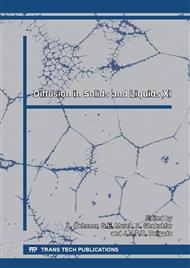p.24
p.30
p.36
p.42
p.48
p.53
p.59
p.65
p.71
Fabrication of Foam-Type Porous Silicon Carbide without Cracks and Hollow Struts
Abstract:
Foam-type porous silicon carbide (SiC) ceramics without cracks and hollow struts were fabricated using the polymer replica method with polycarbosilane (PCS) and polyurethane (PU) foam as the starting materials. The synthesized porous SiC was analyzed using X-ray diffraction and scanning electron microscopy. The results revealed that a porous SiC ceramic structure was formed with a dense framework at a low temperature of 1200°C. During the heat-treatment process, the PCS experienced an organic–inorganic transformation and then converted to the SiC ceramics. It was determined that the organic–inorganic transformation of PCS, which was the stage of silicon oxycarbide formation, is affected by the curing condition. In this study, the optimum curing condition was determined to be an air atmosphere at 200°C for 7 h.
Info:
Periodical:
Pages:
48-52
Citation:
Online since:
July 2016
Keywords:
Price:
Сopyright:
© 2016 Trans Tech Publications Ltd. All Rights Reserved
Share:
Citation:


